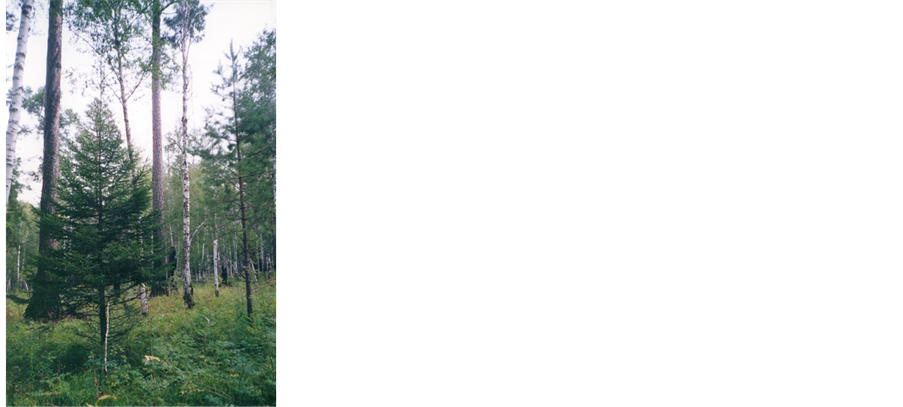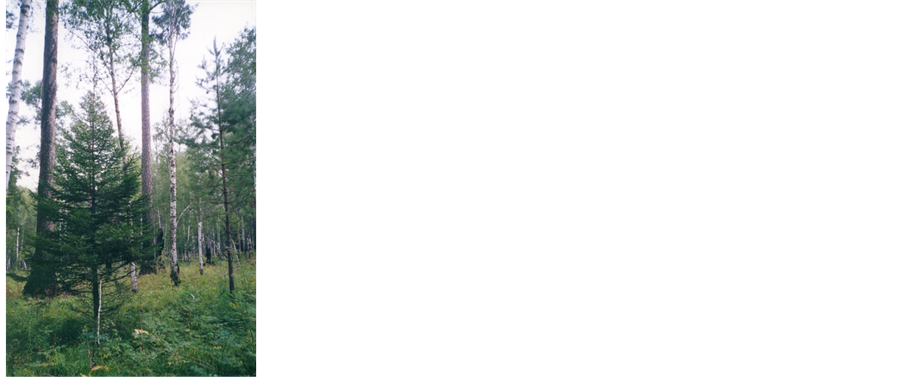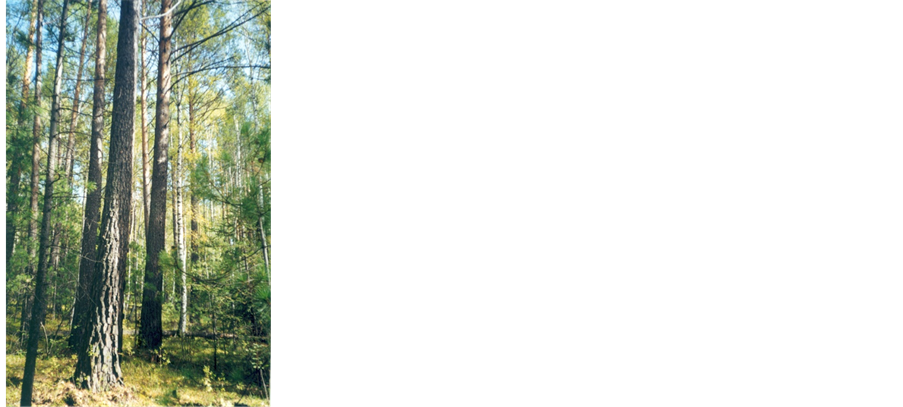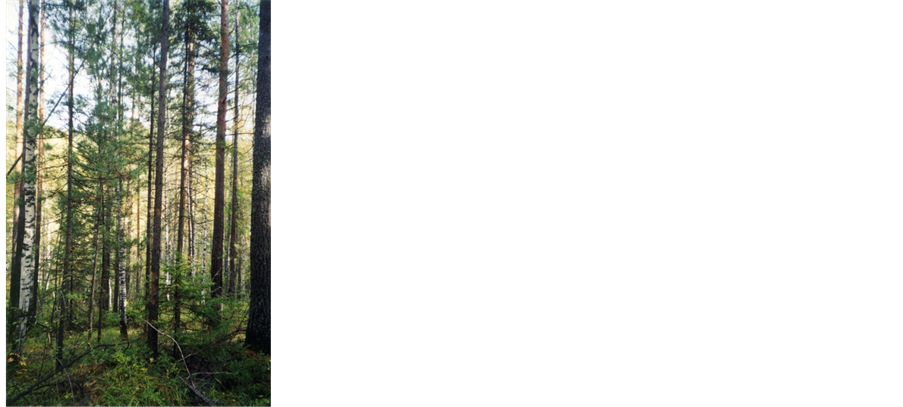Open Access Library Journal
Vol.04 No.09(2017), Article ID:78901,12 pages
10.4236/oalib.1103893
The Structural-Dynamic Organization and Trends of Forests Reconstitution in the South-Western Pre-Baikal (Irkutsk Region, Siberia)
Alexander Sizykh1, Alexey Shekhovtsov2
1Institute of Plant Physiology and Biochemistry, Siberian Branch, Russian Academy of Sciences,, Irkutsk, Russia
2Institute of Geography, Siberian Branch, Russian Academy of Sciences, Irkutsk, Russia

Copyright © 2017 by authors and Open Access Library Inc.
This work is licensed under the Creative Commons Attribution International License (CC BY 4.0).
http://creativecommons.org/licenses/by/4.0/



Received: August 18, 2017; Accepted: September 1, 2017; Published: September 4, 2017
ABSTRACT
At the territories of three key sites with different environmental conditions (coast of Irkutsk Reservoir, the Goloustnaya River basin, surroundings of Gakhany settlement in 60 km northward from the urbanized area Ust’-Orda, Irkutsk Region), we performed studies aimed to reveal the structural-dynamic organization and trends of forests reconstitution at the places of burnt areas and of cuttings of different targets. We took into account the character of impact of anthropogenic factors due to modern land use in the region, in particular. A considerable limitation of cuttings during last decades and decrease of areas was designed for agriculture and pasture on the background of climate dynamics and variability in the region during last years.
Subject Areas:
Biogeography
Keywords:
Structural-Dynamic Organization of Forests, Trends of Forests Reconstitution, South-Western Pre-Baikal, Irkutsk Region

1. Introduction
Within research programs of the Siberian Branch of the Russian Academy of Sciences (programs of RAS SB), we studied a set of questions concerning the problems of the characteristics of the structural-dynamic organization and of forests reconstitutional dynamics of the South-Western Pre-Baikal under different environmental conditions, climate dynamics [1] [2] [3] [4] and of anthropogenic impact. The most important thing was to reveal inducing plants species in the forests communities determining the vector of formation and of forests development under different physical geographic conditions in the southern part of the Baikal Region, where the vegetation was exploited during several decades in different forms and ways. Regional-local environmental conditions determined the modern state and formation of forests with different structure and of different types. The areas of research are showing on the topological map of the region in the longitude and latitude geographical coordinates (Figure 1).
2. Methods
Main research method is geobotanical survey (for 22 years research) with getting of the geobotanical descriptions on the model territories together with the analysis of fund materials (forestry and agriculture) by vegetation state during different years (from 1977 to 2015) of land use in the whole region. In the text of paper there are some characteristic species of the plant communities. Also materials of studies are background ones (for survey), the revealing of plants indicating the structure-dynamic organization and trends of the plant communities and setting of main (characteristic) plants species are sufficient at this studies stage.
3. Results
Key site―coasts of Irkutsk Reservoir (Figure 1(1)). In addition to revealing forests modern state, we performed on the Irkutsk Reservoir coasts―a key site consisting of four model territories, a comparative analysis of forests structure for 22 years from 1993 to 2015.
This studied area is characterized by taiga (boreal) vegetation of Central Siberia formation of subtaiga (submountain) forests [5] belonging according to geobotanical zoning to the Central Siberia taiga area of Irkutsk-Cheremkhovo subtaiga province of the forests of Upper Angara subtaiga-steppe district [6] . The vegetation is considerably disturbed by different anthropogenic impacts, mainly by cuttings in the beginning of the last century, by fires of different forms and intensity during many years [7] . By data for 2015, main vegetation cover of the model territory―interfluve of the Bol’shaya and the Tal’tsinka Rivers―consists of larch (Larix sibirica Ledeb.)―pine (Pinus sylvestris L.) forests, often with inclusions of birch (Betula pendula Roth) and aspen (Populus tremula L.) with underwood consisting of meadowsweet (Spirea media Fr.Schmidt). Cowberry (Vaccinium vitis-idaea L.) plays a considerable role in the soil cover together with forest motley grasses. Such forests are characteristic for the slopes of different expositions. Small-leaf forests together with swamped meadows form in river valleys and in intermontane narrow valleys (see Figure 2(а) & Figure 2(b)).
Main factors resulting into the formation of these forests are discontinuous
Figure 1. Areas of study: 1―coasts of Irkutsk Reservoir, 2―the Goloustnaya River basin, 3―surroundings of Gakhany settlement, northwestward from Irkutsk.


Figure 2. The watersheds have well-developed pine (Pinus sylvestris L.)-larch (Larix sibirica Ledeb.) forests with Picea obovata Ledeb. and underwood of rhododendron (Rhododendron dauricum L.) and duschekia (Duschekia fruticosa (Rupr.) Pouzar) with motley grasses and bracken (Pteridium aquilinum (L.) Kuhn).
fires and cuttings in the first half of the last century.
The forests of the model territories―Alanka and Malolentyaya creek valleys― are presented by pine (Pinus sylvestris L.) forests with larch (Larix sibirica Ledeb.). At the near-watershed areas and in watersheds, cedar (Pinus sibirica Du Tour)―pine (Pinus sylvestris L.) forests form with inclusions of larch (Larix sibirica Ledeb.), fir (Abies sibirica Ledeb.), motley grasses and green mosses (Polytrichym juniperum Hedw., Dicranum polysetum Sw., Aulacomnium palustre (Hedw.) Schwaegr., Abietinella abietina (Turn.) Fleisch., Climacium dendroides (Hedw.) Web. et Mohr, Pleurozium schreberi (Brid.) Mitt., Ptilium crista-castrensis (Hedw.) De Not., Rhytidium rugosum (Hedw.) Kindb., Hylocomnium splendens (Hedw.) B.S.G.) (see Figure 3(а) & Figure 3(b)).
In the undergrowth of pine forests at the slopes of south-western exposition, cedar (Pinus sibirica Du Tour) is available everywhere as undergrowth and sprouts. At the modern stage of forests development on this territory, there are trends of reconstitution of polydominant light coniferous-dark coniferous taiga at the place of total cuttings at the beginning of the 20th century.
The forests of model territory―Sinnushka and Zakharovskiye Lozhki―are characterized by formation of forests of different age containing birch (Betula pendula Roth), larch (Larix sibirica Ledeb.), pine (Pinus sylvestris L.), aspen (Populus tremula L.) (Figure 4(а) & Figure 4(b)).
Basic undergrowth consists of birch (Betula pendula Roth), aspen (Populus tremula L.) and pine (Pinus sylvestris L.). There are sprouts of larch (Larix sibirica Ledeb.), the underwood is dominated by rhododendron (Rhododendron dauricum L.) with inclusions of dog rose (Rosa acicularis Lindley). Near-watershed sites and slopes are characterized by forests often prevailed by birch (Betula pendula


Figure 3. Larch (Larix sibirica Ledeb.)-pine (Pinus sylvestris L.) with Abies sibirica Ledeb. rhododendron (Rhododendron dauricum L.) forests at the slopes of Irkutsk Reservoir coasts.


Figure 4. A considerable part in the timber stand belongs to birch (Betula pendula Roth) and aspen (Populus tremula L.) with yang (7 - 15 years old) trees―Larix sibirica Ledeb., Picea obovata Ledeb.
Roth) and aspen (Populus tremula L.). The narrow valleys are shrubby and, together with meadow communities, they are swamped somewhere. Leading cenotic role belongs to plants species of sedges genus Carex. Under the conditions of elevated anthropogenic impacts such as timber cut for firewood by local people and of ground fires on that territories, there is formation of steady secondary forests with dominance of small-leaf trees species.
The structure of the forests of a model territory―the Kaya and the Kheya Rivers interfluve―is characterized by a high mosaicism and heterogenous composition of the community. Birch (Betula pendula Roth)―pine (Pinus sylvestris L.) forests with larch (Larix sibirica Ledeb.) form at the burnt sites of different years with timber stand of different age (see Figure 5(а) & Figure 5(b)).
The underwood is characterized by Daurian rhododendron (Rhododendron dauricum L.) and by bushes of duschekia (Duschekia fruticosa (Rupr.) Pouzar). Main soil cover is formed by plants species of woodreeds genus Calamagrostis, as well as by ledum (Ledum palustre L.), and blueberry (Vaccinium uliginosum L.)


Figure 5. Pine (Pinus sylvestris L.) forests with larch (Larix sibirica Ledeb.) and birch (Betula pendula Roth) forests. On the whole model site, cedar (Pinus sibirica Du Tour) and fir (Abies sibirica Ledeb.) occur at the stage of undergrowth and young growth.
is spread synusially in lowerings. A high cenotic role is played by horsetails (Equisetum), sedges (Carex spp.) and bracken (Pteridium aquilinum (L.) Kuhn). The presence of cedar (Pinus sibirica Du Tour) is particularly noticeable in the forests of near-watershed sites and of graded surfaces. The trends of forests reconstitution on this model territory reflect formation of light coniferous―dark coniferous polydominant taiga on the places of cuttings and fires of past years. It is to notice that on the whole key site (see Figure 1(1)), the formation occurs at the contact boundary of subtaiga light coniferous forests, polydominant light coniferous-dark coniferous taiga characteristic for the South-Western Pre-Baikal in the whole.
Key site―the Goloustnaya River basin (Figure 1(2)). The forests of the next key site―the Goloustnaya River basin―is related, according geobotanical zoning, to Central Siberian taiga area of Irkutsk-Cheremkhovo province of pine (Pinus sylvestris L.) and larch (Larix sibirica Ledeb.)―pine (Pinus sylvestris L.) forests of Upper Angara subtaiga-steppe (birch-pine) district (the Goloustnaya R. upper reach) and to Baikal-Dzhugdzhur goltsy-mountain-taiga area of Pre- Baikalian mountain-tundra-dark coniferous taiga province of Pre-Baikalian mountain-tundra-dark coniferous mountain taiga district (middle and lower currents of the Goloustnaya R.), often―of steppificated subtaiga (submountain) forests in upper reaches and of Central Siberian formations of mountain-taiga fir (Abies sibirica Ledeb.)-cedar (Pinus sibirica Du Tour), larch (Larix sibirica Ledeb.)-cedar (Pinus sibirica Du Tour) forests with spruce (Picea obovata Ledeb.) and of larch (Larix sibirica Ledeb.) undershrub (Vaccinium vitis-idea L.)-moss (Ptilium crista-castrensis (Hedw.) De Not., Rhytidium rugosum (Hedw.) Kindb., Dicranum polysetum Sw., Aulacomnium palustre (Hedw.) Schwaegr., Abietinella abietina (Turn.) Fleisch.) forests in the basin of the Goloustnaya R. lower reach [7] .
Alongside with forests, the cuttings resulted in the formation of mainly second growth, often with dominance of birch (Betula pendula Roth) and aspen (Populus tremula L.). Total cuttings, destruction of undergrowth and change of conditions (mainly soil ones) for reconstitution initiated here development of small-leaf forests, which are subject to fires, often catastrophic ones. The performed studies of modern state and trends of forests reconstitution revealed characteristic features of communities development at different sites. On the base of geobotanical survey together with establishment of model points, trends of forests development are found out for different types of habitats. In the structure of larch (Larix sibirica Ledeb.)―pine (Pinus sylvestris L.) forest with birch (Betula pendula Roth), cowberry (Vaccinium vitis-idaea L.), green moss (Rhytidium rugosum (Hedw.) Kindb., Dicranum polysetum Sw.) and inclusions of ledum (Ledum palustre L.), which forms at burnt sites (upper stream of the Goloustnaya R.), a considerable role belongs to cedar (Pinus sibirica Du Tour) and larch (Larix sibirica Ledeb.) in the second synfolium of timber stand. The undergrowth of these forests is dominated by cedar (Pinus sibirica Du Tour) and fir (Abies sibirica Ledeb.), while larch (Larix sibirica Ledeb.) and pine (Pinus sylvestris L.) are not abundant (Figure 6).
Birch (Betula pendula Roth)―pine (Pinus sylvestris L.) forest with cowberry (Vaccinium vitis-idaea L.), motley grasses and sedge (Carex spp.) at the slopes of north-western expositions is characterized by presence of single cedars (Pinus sibirica Du Tour) and spruces (Pinus sylvestris L.), young growth and undergrowth are dominated by cedar (Pinus sibirica Du Tour) and spruce (Picea obovata Ledeb.), pine (Pinus sylvestris L.) occurrence is not significant. In larch (Larix sibirica Ledeb.)―pine (Pinus sylvestris L.) forests with spruce (Picea obovata Ledeb.), cedar (Pinus sibirica), motley grasses, sedge (Carex spp.), cowberry (Vaccinium vitis-idaea L.) and synusia of mosses (Polytrichym juniperum Hedw., Dicranum polysetum Sw., Aulacomnium palustre (Hedw.) Schwaegr., Abietinella abietina (Turn.) Fleisch., Climacium dendroides (Hedw.) Web. et


Figure 6. Basic forest vegetation consists of Central Siberian formation of pine (Pinus sylvestris L.) and larch (Larix sibirica Ledeb.)-pine (Pinus sylvestris L.) forests with rhododendron (Rhododendron dauricum L.), cowberry (Vaccinium vitis-idaea L.) and motley grasses. The forests of this area served during a long period as a raw for great forest cutting, especially in middle part of last century.
Mohr., Pleurozium schreberi (Brid.) Mitt., Ptilium crista-castrensis (Hedw.) De Not., Rhytidium rugosum (Hedw.) Kindb., Hylocomnium splendens (Hedw.) B.S.G.) at bottoms of slopes of western and south-western expositions, young growth and undergrowth are formed by cedar (Pinus sibirica Du Tour) and spruce (Picea obovata Ledeb.) with inclusions of larch (Larix sibirica Ledeb.). At burnt sites of pine (Pinus sylvestris L.) rhododendron (Rhododendron dauricum L.) forest with duschekia shrub (Duschekia fruticosa (Rupr.) Pouzar) and meadowsweet (Spirea media L.) at near-top parts of slopes of banks of the Goloustnaya R. tributaries, pine (Pinus sylvestris L.) undergrowth with inclusions of cedar (Pinus sibirica Du Tour) forms with soil cover of cereals and mosses synusia. At the aprons of the slopes of south-western exposition at the boards of middle current of the Goloustnaya R., at the places of cuttings done 50 years ago, an aspen (Populus tremula L.)―birch (Betula pendula Roth) forest forms, including green mosses, motley grasses and sedge (Carex spp.). The underwood of these forests consists of duschekia shrub (Duschekia fruticosa (Rupr.) Pouzar), Daurian rhododendron (Rhododendron dauricum L.) forest with sedge (Carex spp.). Basic undergrowth of this forest consists of pine (Pinus sylvestris L.), larch (Larix sibirica Ledeb.) and spruce (Picea obovata Ledeb.). At burnt sites of polydominant pine (Pinus sylvestris L.)―larch (Larix sibirica L.) forests with inclusions of dark coniferous trees species, a pine (Pinus sylvestris L.) forest forms with inclusions of larch (Larix sibirica Ledeb.), birch (Betula pendula Roth), green mosses (Pleurozium schreberi, Ptilium crista-castrensis, Rhytidium rugosum), motley grasses, sedge (Carex spp.). The underwood of these forests consists of duschekia shrub (Duschekia fruticosa (Rupr.) Pouzar), Daurian rhododendron (Rhododendron dauricum L.) with occurrence of dog rose (Rosa acicularis Lindley). Cowberry (Vaccinium vitis-idaea L.) is a base of soil cover. Undergrowth with dominance of pine (Pinus sylvestris L.) is very representative for pine (Pinus sylvestris L.)-larch (Larix sibirica Ledeb.) forests with birch (Betula pendula Roth), rhododendron (Rhododendron dauricum L.) and with soil cover consisting of cowberry (Vaccinium vitis-idaea L.), north twinflower (Linnaea borealis) and shinleaves (Pyrola asarifolia Michaux, Pyrola rotundifolia L.) forming at the place of burnt larch (Larix sibirica Ledeb.)-pine (Pinus sylvestris L.) forest in the surroundings of Maloye Goloustnoye settlement. Occurrence of larch (Larix sibirica Ledeb.) and cedar (Pinus sibirica Du Tour) is found as well. In larch (Larix sibirica Ledeb.)-pine (Pinus sylvestris L.)-birch (Betula pendula Roth) forests with rhododendron (Rhododendron dauricum L.), cowberry (Vaccinium vitis-idaea L.), green mosses (Polytrichym juniperum Hedw., Dicranum polysetum Sw., Aulacomnium palustre (Hedw.) Schwaegr., Abietinella abietina (Turn.) Fliesch., Climacium dendroides (Hedw.) Web.et Mohr., Pleurozium schreberi (Brid.) Mitt., Ptilium crista-castrensis (Hedw.) De Not., Rhytidium rugosum (Hedw.) Kindb., Hylocomnium splendens (Hedw.) B.S.G.) in lower current of the Goloustnoye R., base of young growth and undergrowth consists of cedar (Pinus sibirica Du Tour) with sprouts of spruce (Picea obovata Ledeb.) and larch (Larix sibirica Ledeb.).
In the above listed descriptions of structural-dynamic organization of forests, there are rather ambiguous trends of forests reconstitutions at cutting and burning sites of different intensity. Simultaneous processes occur here: both forestation of steppe sites (“stepoids”), especially on the slopes of south-western expositions, and formation of steppe vegetation groups at total recent burnt sites. For this studied area (the Goloustnaya R. basin), paragenese in vegetation formation is appropriate; this is reflected in forest reconstitution character. There are different opinions about paragenese phenomenon in formation of some environments [8] [9] [10] . But in our opinion, it is manifested for bvegetation as follows: specific local environmental conditions on the background of climate recent dynamics and variability result in formation of communities with features of a structure of zonal vegetation type (or a height belt) alongside with the development of extrazonal effects in vegetation cover organization. All these phemomena occur simultaneously, and extrazonality is temporary. We understand paragenese as existing of communities of different types and related to different vegetation types by their structure at the same territory.
Key site―surroundings of Gakhany settlement, northwestward from Irkutsk (Figure 1/3). According to geobotanical zoning [6] , the vegetation at this key site, contact zone of light coniferous taiga and extrazonal steppes, is related to Irkutsk-Cheremkhovo province of pine (Pinus sylvestris L.) and larch (Larix sibirica Ledeb.)-pine (Pinus sylvestris L.) forests of Upper Angara subtaiga-steppe (birch-pine) district. Forest vegetation consists of Central Siberian formations of pine (Pinus sylvestris L.) and larch (Larix sibirica Ledeb.)-pine (Pinus sylvestris L.) subtaiga (submountain) forests with rhododendron (Rhododendron dauricum L.), cowberry (Vaccinium vitis-idaea L.) and motley grasses, often steppificated at the boundary with forests of Central Siberia taiga area of Lena-Angara mountain taiga province of Anga mountain-taiga dwarf birch-larch district. In this studied area, basic forests consist of pine (Pinus sylvestris L.) and larch (Larix sibirica Ledeb.)-pine (Pinus sylvestris L.) trees species. The studies were performed directly on the territory of forest transition into extrazonal steppe, formation of which, in turn, is due to mainly anthropogenic impact-cutting with subsequent ploughing up of large territories for cereals. This was especially typical for the beginning and middle part of the 20th century. During last decades, forestation of open (often steppificated) sites is found out everywhere (see Figure 7).
Basic steppificated forests here consist of pine (Pinus sylvestris L.) with inclusions of larch (Larix sibirica Ledeb.) and motley grasses; trees species forming forests are aged under 35. The response to climate dynamics and variability of the background of decrease of anthropogenic impact resulted in formation of rather steady forest massifs extending gradually onto territories ploughed up before. It is to notice that species composition of soil cover is considerably represented by meadow-forest plants species characteristic for polydominant light coniferous taiga of Pre-Baikalian type. E.g., pine (Pinus sylvestris L.) forests with green mosses and motley grasses are replaced by pine (Pinus sylvestris L.)


Figure 7. There are in the spatial structure of vegetation of this key site well-developed extrazonal effects, there is here a zone of contact of extrazonal steppes, subtaiga light coniferous forests (Pinus sylvestris L., Larix sibirica Ledeb.) and zonal taiga of the south of Siberia. Basic soil cover consists of steppe and meadow-steppe plants species such as Agropyron cristatum (L.) Beauv., Festuca lenensis Drobov., Koeleria cristata (L.) Pers., Phleum phleoides (L.) Karsten, Poa botryoides (Trin. Ex Griseb.) Kom., Stipa krylovii Roshev et al.
forests aged under 35 with young motley grasses extending onto territories ploughed up before everywhere in extrazonal steppes. It is to notice here abundant sprouts of pine (Pinus sylvestris L.) both under timber stand canopy and on open areas. However, in some cases, especially on graded slopes, there are processes of steppification of forests at the boundary with extrazonal steppe communities as phenomenon for this part of Western Pre-Baikal. Like in the previous case, there is here paragenese (object) in vegetation formation manifested in trend of forests reconstitution. This is typical for vegetation of transitional environmental conditions.
4. Conclusion
Structural-dynamic organization and trends of forests reconstitution at different territories of South-Western Pre-Baikal are characterized by timber stand formation with extension of dark coniferous species among light coniferous forests. This is characteristic for vegetation on the coasts of Irkutsk Reservoir (see Figure 1(1)) and for the Goloustnaya River basin (see Figure 1(2)). Forestation of steppe areas including ploughed up before ones (see Figure 1(3)) at the contact of light coniferous forests and extrazonal steppes suggests changes in the climatic situation in the region. Under transitional environmental conditions (environments contact), paragenese (subject) resulting from paragenesis (phenomenon) is quite normal, this is real difference in structural-dynamic organization of vegetation. The analysis of obtained data of perennial studies of forests reconstitution trends under different environmental conditions allows to forecast a vector in development of forests (and of vegetation in the whole) under changeable climate conditions and under anthropogenic impact of different character onto vegetation on wide territories of the whole Baikal Region.
Cite this paper
Sizykh, A. and Shekhovtsov, A. (2017) The Structural- Dynamic Organization and Trends of Forests Reconstitution in the South-Western Pre-Baikal (Irkutsk Region, Siberia). Open Access Library Journal, 4: e3893. https://doi.org/10.4236/oalib.1103893
References
- 1. Gustokashina, N.N. (2003) Long-Term Changes of the Main Climate Elements on the Territory of the Pre’Baikal. Institute of Gejgraphy of RAS SB Publishing House, Irkutsk, 108 p.
- 2. Maksytova, Ye.V. (2012) Characteristics of the Snow Cover in Pre-Baikalian Forest-Steppe. Ice and Snow, 1, 54-61.
- 3. Maksytova, Ye.V. (2013) Perennial Oscillations of Snow Cover Thickness and Maximal Snow Stocks on the Pre-Baikalian Territory. Ice and Snow, 2, 40-47.
- 4. Maksytova, Ye.V., Kichigina, N.V., Voropay, N.N., Balybina, A.S. and Osipova, O.P. (2012) Trends of Hydroclimatic Changes at the Baikalian Environmental Territory. Georafia i Prirodnye Rewsursy, 4, 72-81.
- 5. Sochava, V.B. (1972) Vegetation of the South of the East Siberia. Map (Scale 1:1,500,000). Head Department of Geodesy and Cartography, Moscow, 4 Sheets.
- 6. Belov, A.V., Layamkin, V.F. and Sokolova, L.P. (2002) Mapping Study of the Biota. “Oblmashinform” Publishing House, Irkutsk, 160 p.
- 7. Belov, A.V. (1990) Vegetation. In: Nature Use and Environment Conservation in the Lake Baikal Basin, Nauka Publishing House, Novosibirsk, 41-48.
- 8. Grishankov, G.Y. (1977) Paragenetic Systems of Natural Zones (Illustrated by Crimea). In: Systematic Natural Research, Nauka Publishing House, Moscow, 128-139.
- 9. Ivanovsky, L.N. (2001) Paragenese and Paragenesis of Mountain Relief in the South of Siberia. Institute of Geography of RAS SB Publishing House, Irkutsk, 142 p.
- 10. Kulikov, A.I., Bazhenov, V.S. and Ivanov, N.V. (2006) Soils Paragenesis and Paradinamics. BSC of RAS SB Publishing House, Ulan-Ude, 280 p.


